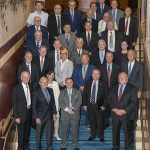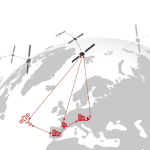The engineering team behind the signal technology underpinning Europe’s Galileo satellite navigation system has reached the final of this year’s European Inventor Award.
The European Patents Office has nominated a team led by Spanish engineer José Ángel Ávila-Rodríguez – now part of ESA’s Galileo team – and his French colleague Laurent Lestarquit from France’s CNES space agency. Ávila-Rodríguez and Lestarquit are each regular contributing writers for Inside GNSS.
The engineering team behind the signal technology underpinning Europe’s Galileo satellite navigation system has reached the final of this year’s European Inventor Award.
The European Patents Office has nominated a team led by Spanish engineer José Ángel Ávila-Rodríguez – now part of ESA’s Galileo team – and his French colleague Laurent Lestarquit from France’s CNES space agency. Ávila-Rodríguez and Lestarquit are each regular contributing writers for Inside GNSS.
The team includes German Günter Hein, formerly head of the department studying the evolution of EGNOS and Galileo for the European Space Agency (ESA), as well as Belgian Engineer Lionel Ries, now in ESA’s technical directorate, and French CNES engineer Jean-Luc Issler. Ries and Issler also are Inside GNSS contributors and Hein coordinates the magazine’s regular Working Papers column.
The engineers, who had previously worked together as members of the multinational Galileo Signal Task Force, came up with a pair of innovative signal modulation techniques to pack multiple Galileo signals together, simultaneously serving different sets of users while boosting signal performance and robustness. Both innovations have been adopted by Galileo and are in use today.
The first technique, called Alternative Binary Offset Carrier modulation, or “AltBOC” for short, combines four signals into one large one, resulting in the widest bandwidth navigation signal ever transmitted. Two of these signals are sitting on the one carrier, namely E5a, while the other two are on E5b.
“AltBOC is a way of transmitting four components in a very wide bandwidth signal, using a single radio frequency chain on the satellite in an intelligent way, where originally two chains would have been needed to transmit in two separate frequency bands (E5a and E5b),” explains Ávila-Rodríguez, now ESA’s Global Navigation Satellite System Evolution Signal and Security Principal engineer for Galileo.
The result is a frequency-rich signal that fundamentally improves positioning performance and robustness.
“AltBOC is interoperable with GPS in E5a/L5 and allows receiver manufacturers to process it as one very large signal – extending over the whole E5a and E5b range – or as two separate signals, one at each frequency carrier (E5a or E5b),” he adds.
“AltBOC serves open service users in general. Moreover, when used in its full performance mode (E5a+E5b), it also facilitates geodetic and precision scientific applications such as gradual tectonic motion, or the use of accurate positioning on Earth – including proposed ‘reflectometry’ missions to make altimetry measurements from satnav signals reflected from Earth’s surface.”
The team adds that the application of AltBOC could go beyond the current use by providing accurate positioning to satellites in space thanks to its unique bandwidth characteristics.





